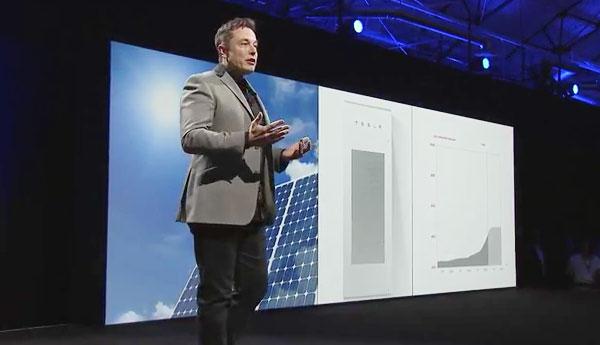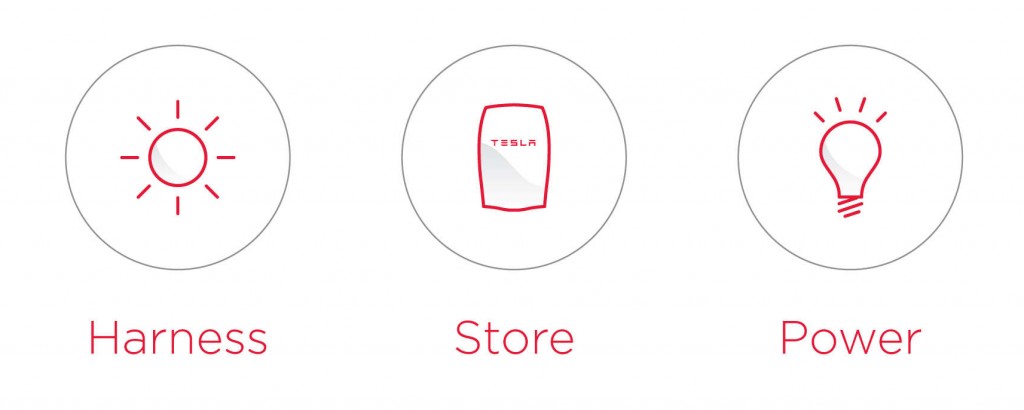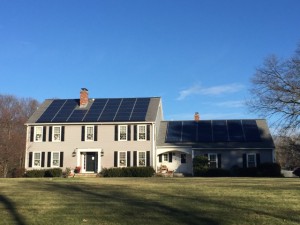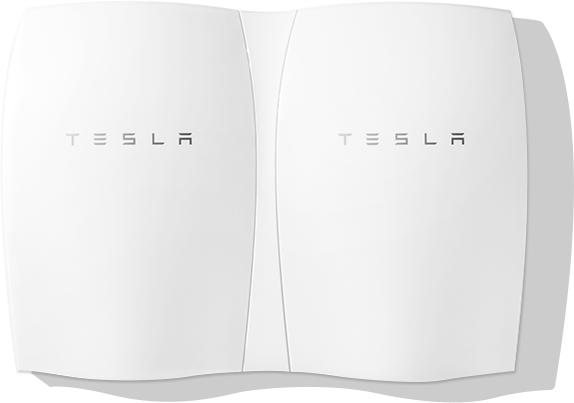Energy
Bloomberg Says Tesla Powerwall Doesn’t Make Sense
Bloomberg News says the Tesla Powerwall doesn’t make sense. So why have 38,000 folks signed up to own or lease one when deliveries won’t start for 6 months?

Bloomberg News questions whether the Tesla Powerwall — introduced to great fanfare on April 30 — makes economic sense. Their answer? It doesn’t — at least not now. Here’s why.
The Powerwall comes in two versions — a 7 kWh (kilowatt-hour) model and a 10 kWh unit. The smaller battery is design specifically for daily use. The larger battery is strictly a backup power supply.
SolarCity, Tesla’s sister company, has decided not to offer the 7 kWh battery with its rooftop solar systems. That battery “doesn’t really make financial sense,” SolarCity spokesman Jonathan Bass tells Bloomberg. That’s because customers can make money selling their excess solar power back to the grid during the day when rates are high rather than using it to charge up a battery.
Of course, the economics will vary considerably across the country. Not all states require utilities to accept electricity from home solar systems and each electric company has its own rate structure.
SolarCity Offers Larger Powerwall
SolarCity says it will only offer the 10 kWh battery to new rooftop solar customers. “Our residential offering is battery backup,” Bass said in an e-mail. Unlike the smaller unit, which is intended for daily use, the 10 kWh battery is designed for no more than 50 discharge cycles a year. Homeowners can buy it outright for $7,140, including an inverter and installation, or lease it for $15 a month for 9 years with an upfront payment of $5,000.
The 10 kWh battery is rated at 2 kilowatts of continuous power. Does that sound like a lot? It’s not. That’s only enough to run a hair dryer or 2 small window air conditioners for about 5 hours. To provide enough electricity to power a typical home would take eight Powerwall units working together. According to Bloomberg, that would cost $45,000 (if the nine year lease option is selected). There are no known discounts for multiple purchases at this time.
“It’s a luxury good—really cool to have—but I don’t see an economic argument,” said Brian Warshay, an energy and smart technologies analyst with Bloomberg New Energy Finance. Bloomberg suggests you could get the same back up capability from a $3,700 generator available at Home Depot.
Demand Is “Crazy”
The Powerwall that has captured the public’s imagination has a long way to go before it makes economic sense for most people. Even in Germany, where solar power is abundant and electricity prices are high, the economics of an average home with rooftop solar “are not significantly enhanced by including the Tesla battery,” according to an analysis by Bloomberg New Energy Finance.
None of this has dampened the enthusiasm of prospective Powerwall users. Since Elon Musk’s announcement last week, the company has received inquiries from 38,000 people. Demand is so strong, Tesla is considering using its GigaFactory exclusively for residential and commercial storage batteries instead of batteries for its automobiles. There are even rumors it plans to expand the GigaFactory, which isn’t even built yet. Musk says demand has been “crazy off the hook.” He acknowledges that the Powerwall is more expensive than grid power, but says, “that doesn’t mean people won’t buy it.”
If the numbers don’t add up, why would people be in such a frenzy to get a Powerwall of their very own? SolarCity’s Bass says, “There’s a tremendous amount of interest in backup power that’s odorless, not noisy and completely clean.” But its more than that. Some observers call it “The Prius Effect”. Once you think someone else has something new and sexy, you want one for yourself. It’s just human nature.
Elon Musk is a master at creating buzz and then leveraging it. Everywhere you look this week, there are news stories about the Powerwall and what a huge leap forward it is. If all the people who signed up after last week’s announcement follow through, all those new orders will amount to $800 million in new business for the company. The orders are continuing to pour in like a flood tide into the Bay of Fundy.
Tesla Drives Costs Down
Is there anything truly remarkable about the Tesla Powerwall? Yes, there absolutely is. Based on the asking price for the Powerwall, Tesla has managed to get the cost of its batteries down to $250 per kilowatt-hour, something the “experts” claimed couldn’t happen before 2020. That gives Tesla a sizable marketing advantage over other battery companies and that’s before the GigaFactory starts production. Once that comes online, battery prices will undoubtedly fall even more. Musk’s faith in economies of scale seems to be paying off.
What’s Ahead For Tesla?
The truth is that Tesla is really not in the “off the grid” home battery market right now, although there is talk about offering batteries to residents of Hawaii, where electricity costs triple what it does on the mainland. Tesla really has its sights set on commercial and utility scale products. Utility companies often charge commercial and industrial customers their highest rates.

Business and industry can now charge their Tesla PowerPacks at night when rates are low. Or they can use solar panels to charge them during the day. Either way, they avoid buying electricity from utility companies at peak demand rates.
A battle is shaping up between energy makers and energy storage providers. The outcome will be nothing less than an upheaval in the way electricity is made and distributed. Battery storage is disruptive technology and there is no one who is more of a champion of disruptive technology than Elon Musk.
In 10 years, residential battery storage systems will be as common as stoves and refrigerators. No home will be without one. SolarCity’s Bass suggests that’s when the Tesla Powerwall will begin to make economic sense. Microgrids that soak up energy from the sun to charge grid scale batteries will be everywhere. Utility companies as we know them will become marginal players. The Rocky Mountain Institute predicts that demand for electricity from traditional utility companies will decline by 50% in the next 10 years.
As the market for electricity changes, there will be winners and losers. There is no question Elon Musk plans on being one of the winners.
Source: Bloomberg News

Cybertruck
Tesla updates Cybertruck owners about key Powershare feature

Tesla is updating Cybertruck owners on its timeline of a massive feature that has yet to ship: Powershare with Powerwall.
Powershare is a bidirectional charging feature exclusive to Cybertruck, which allows the vehicle’s battery to act as a portable power source for homes, appliances, tools, other EVs, and more. It was announced in late 2023 as part of Tesla’s push into vehicle-to-everything energy sharing, and acting as a giant portable charger is the main advantage, as it can provide backup power during outages.
Cybertruck’s Powershare system supports both vehicle-to-load (V2L) and vehicle-to-home (V2H), making it flexible and well-rounded for a variety of applications.
However, even though the feature was promised with Cybertruck, it has yet to be shipped to vehicles. Tesla communicated with owners through email recently regarding Powershare with Powerwall, which essentially has the pickup act as an extended battery.
Powerwall discharge would be prioritized before tapping into the truck’s larger pack.
However, Tesla is still working on getting the feature out to owners, an email said:
“We’re writing to let you know that the Powershare with Powerwall feature is still in development and is now scheduled for release in mid-2026.
This new release date gives us additional time to design and test this feature, ensuring its ability to communicate and optimize energy sharing between your vehicle and many configurations and generations of Powerwall. We are also using this time to develop additional Powershare features that will help us continue to accelerate the world’s transition to sustainable energy.”
Owners have expressed some real disappointment in Tesla’s continuous delays in releasing the feature, as it was expected to be released by late 2024, but now has been pushed back several times to mid-2026, according to the email.
Foundation Series Cybertruck buyers paid extra, expecting the feature to be rolled out with their vehicle upon pickup.
Cybertruck’s Lead Engineer, Wes Morrill, even commented on the holdup:
As a Cybertruck owner who also has Powerwall, I empathize with the disappointed comments.
To their credit, the team has delivered powershare functionality to Cybertruck customers who otherwise have no backup with development of the powershare gateway. As well as those with solar…
— Wes (@wmorrill3) December 12, 2025
He said that “it turned out to be much harder than anticipated to make powershare work seamlessly with existing Powerwalls through existing wall connectors. Two grid-forming devices need to negotiate who will form and who will follow, depending on the state of charge of each, and they need to do this without a network and through multiple generations of hardware, and test and validate this process through rigorous certifications to ensure grid safety.”
It’s nice to see the transparency, but it is justified for some Cybertruck owners to feel like they’ve been bait-and-switched.
Energy
Tesla starts hiring efforts for Texas Megafactory
Tesla’s Brookshire site is expected to produce 10,000 Megapacks annually, equal to 40 gigawatt hours of energy storage.

Tesla has officially begun hiring for its new $200 million Megafactory in Brookshire, Texas, a manufacturing hub expected to employ 1,500 people by 2028. The facility, which will build Tesla’s grid-scale Megapack batteries, is part of the company’s growing energy storage footprint.
Tesla’s hiring efforts for the Texas Megafactory are hinted at by the job openings currently active on the company’s Careers website.
Tesla’s Texas Megafactory
Tesla’s Brookshire site is expected to produce 10,000 Megapacks annually, equal to 40 gigawatt hours of energy storage, similar to the Lathrop Megafactory in California. Tesla’s Careers website currently lists over 30 job openings for the site, from engineers, welders, and project managers. Each of the openings is listed for Brookshire, Texas.
The company has leased two buildings in Empire West Business Park, with over $194 million in combined property and equipment investment. Tesla’s agreement with Waller County includes a 60% property tax abatement, contingent on meeting employment benchmarks: 375 jobs by 2026, 750 by 2027, and 1,500 by 2028, as noted in a report from the Houston Business Journal. Tesla is required to employ at least 1,500 workers in the facility through the rest of the 10-year abatement period.
Tesla’s clean energy boom
City officials have stated that Tesla’s arrival marks a turning point for the Texas city, as it highlights a shift from logistics to advanced clean energy manufacturing. Ramiro Bautista from Brookshire’s economic development office, highlighted this in a comment to the Journal.
“(Tesla) has great-paying jobs. Not just that, but the advanced manufacturing (and) clean energy is coming to the area,” he said. “So it’s not just your normal logistics manufacturing. This is advanced manufacturing coming to this area, and this brings a different type of job and investment into the local economy.”
Energy
Tesla and Samsung SDI in talks over new US battery storage deal: report
The update was related by industry sources and initially reported by South Korean news outlets.

Recent reports have suggested that Tesla and Samsung SDI are in talks over a potential partnership to supply batteries for large-scale energy storage systems (ESS).
The update was related by industry sources and initially reported by South Korean news outlets.
ESS batteries to be built at Samsung’s Indiana plant
As noted in a report from Korea JoongAng Daily, the demand for energy storage systems has been growing rapidly in North America, thanks in no small part to the surge in AI investments across numerous companies. With this in mind, Tesla has reportedly approached Samsung SDI about a potential battery supply deal.
The deal is reportedly worth over 3 trillion Korean won (approximately $2.11 billion) and will span three years, according to The Korea Global Economic Daily. A battery supply deal with Samsung SDI could make sense for Tesla as the company already has a grid-scale battery, the Megapack, which is perfect for industrial use. Samsung SDI could simply supply cells for the EV maker.
Production of the batteries would reportedly take place at Samsung SDI’s joint venture factory with Stellantis in Indiana, which is currently under construction. Samsung SDI recently announced plans to use part of that plant’s EV lines to produce cells for ESS, with a targeted capacity of 30 GWh by the end of next year.
Tesla and Samsung’s partnership
At present, only a handful of manufacturers, including Korea’s LG Energy Solution, Samsung SDI, SK On, and Japan’s Panasonic, are capable of producing energy storage-scale batteries domestically in the United States. A Samsung SDI official issued a comment about the matter, stating, “Nothing has been finalized regarding cooperation with Tesla.”
The possible energy storage system deal adds another layer to Tesla’s growing collaboration with Samsung, which is already in line as a partner in the upcoming production of Tesla’s AI5 and AI6 chips. Early sample manufacturing of the AI6 is expected to begin in South Korea, with mass production slated for Samsung’s Texas-based Taylor foundry when it starts operations.
The AI6 chip will power Tesla’s next wave of high-volume projects, including the Optimus humanoid robot and the autonomous Cybercab service. Musk has called the partnership with Samsung a “real collaboration,” adding that he personally plans to “walk the line” at the Taylor facility to speed up progress.










